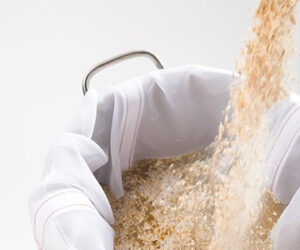Brewing Session Beers: Tips from the Pros
A great session beer (one that comes in at or below about 5% ABV) is ideal for afternoons in the summer sun and events when you want to have a few beers without getting inebriated. While brewing a beer low in ABV isn’t hard, brewing one with the flavor and mouthfeel that resembles a higher-alcohol beer takes great skill and planning in the recipe design. Take the advice of these two pros into your next brew day and you’ll be rewarded with a perfect beer to enjoy after finishing your weekend to-do list.
Travis Smith, Brewmaster at LazyG Brewhouse in Prescott, Arizona

My ideal session beer would smell, taste, and feel like a classically styled beer, just with lower alcohol. The way I approach creating these lower-alcohol beers is to aim for a “real extract” that would mimic the real extract of the base style I am targeting.
While the most important part of achieving the aromas and flavors of a session beer will be similar to brewing any other style of beer (strict controls to limit oxygen exposure, sanitation, freshness, etc.), the mouthfeel and body is one of the more challenging components of brewing a delicious session beer. Using real extract as a comparison instead of just terminal gravity (or apparent extract), I compare the amount of unfermented compounds in the beer in order to aim for a similar level as what would be in my target style.
For example, an IPA starting at 16 °P (1.065 specific gravity) and finishing at 2.5 °P (1.010 SG) would come out around 7.4%, but the finishing gravity at 2.5 °P (1.010 SG) does not tell the whole story of what unfermentables are still in the beer. Because alcohol is lighter than water, alcohol present in beer reduces the “apparent extract” when equating density-to-solids concentration. In the above example, the real extract in the beer is about 5.0 ˚Plato (1.020 SG), which is considerably higher than its apparent extract of 2.5 ˚P (1.010). In order to have a similar mouthfeel and texture to the IPA above but in a session IPA, I would aim for the same real extract in both versions. If our session IPA begins at 11.8 °P (1.047 SG) and finishes at 2.5 °P (1.010 SG) like the IPA did in the example, we are still short on unfermentables. In order to have the same real extract in this beer, we need a terminal gravity of 3.5 °P (1.014 SG), one full degree Plato (or four gravity points) higher than the full strength IPA.
Because brewing with less malt in order to have less alcohol means it would undoubtedly end up with less body given similar parameters, I take two primary measures to reduce the fermentability of the wort. The first is using a higher mash temperature (I will perform a single step infusion mash as high as 156 °F/69 °C if needed). The second difference is through the base recipe. Using malts and grains that are inherently less fermentable combined with higher than average mash rest temperatures can help achieve the higher terminal gravities needed to retain full mouthfeel. Malts and grains that are less fermentable include most specialty malts and with properly improper mashing techniques unmalted grains can have a low degree of fermentability. Generally the darker it is the less fermentable it will be. I like using Maris Otter, Munich, dextrin malts, crystals, unmalted oats, unmalted wheat, and unmalted barley for lighter colored styles. For darker styled session beers the sky’s the limit as roasted malts and grains are not very fermentable.
Casey Motes, Co-Founder and Head Brewer of Eureka Heights Brew Co. in Houston, Texas

My ideal session beer would be complex but light enough where I can drink a couple while mowing my lawn. The finish needs to be clean and make me want to take another sip. Balancing that complexity while creating a clean finish is one of the hardest parts when brewing a session beer.
Whenever we’re developing a new recipe we always ask, can we keep this under 5% ABV and still get everything we want out of the beer. The answer isn’t always a yes, but we’ve found that thinking this way challenges us to focus on every aspect of our beer rather than just hiding behind the ABV.
Here are a few tips we’ve learned brewing session beers:
Malt: We prefer to use a base malt with more character than a standard 2-row. English Maris Otter and German Vienna are good options that bring in flavor while still helping keep the finish clean and crisp. Wheat or flaked oats are common ways to add more body without adding too much sweetness. We’re big fans of using a small amount of Carafoam® in our lower ABV beers (about 3%) for both adding body and helping with head retention. Those malts mashed a little higher, generally around 156 °F (69 °C), create some great wort to layer flavors on top.
Hops: Most of our session beers have a very small bittering addition, typically about 5 IBUs. This allows us to use more hops later while still keeping our overall bitterness in check. If making a hop-forward beer like a pale ale or session IPA, look for hops with aroma and flavor complexity. Citra® and Mosaic® are great choices, but lately we’ve really enjoyed Idaho 7® and Strata®. Our IPAs generally have the majority of the hops in the whirlpool but for our low-ABV beers we keep a 15-minute addition to make sure we are getting enough hop flavor.
Yeast: Look for complexity. We have two house yeasts. The dry English strain creates a dark fruit character that works great in both malt-forward and hoppy beers. The German Kölsch strain produces a nice floral character that works great in lighter styles like blonde ales.


